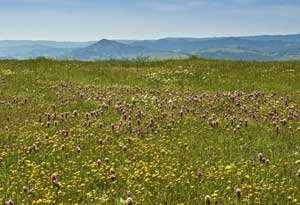THERE is more to a natural landscape than meets the eye. We stand in awed reverence beneath Yosemite Falls or on the rim of the Grand Canyon. Who wouldn’t? The grandeur is overwhelming. But what about those ho-hum areas that we pass without notice? Are those places empty wasteland, or do they hold some importance beyond our ken?
For many years, as I drove north on Highway 101, I paid little notice to Coyote Ridge. There is hardly a shrub or tree to break the monotony of the rolling ridge between Anderson Reservoir and Metcalf Road. It is a bare grassy ridge scarred by a landfill; a landscape easy to overlook.
My education began on one of the docent-led hikes offered each spring by the Santa Clara Valley Open Space Authority. By the time we had climbed to the top of the ridge, I was keenly aware that Coyote Ridge is no barren wasteland, but a unique and critically important habitat. The serpentine rock that underlies the ridge has given rise to a host of plant species that live there and nowhere else. I also learned that unique conditions there support an inconspicuous forb, California plantain (Plantago erecta), the main food source for Bay checkerspot butterfly larvae. Coyote Ridge is a key nursery for this endangered species.
How many times must I learn the lessons my elders taught me: Don’t judge a book by its cover? After a day on Coyote Ridge, I realized this “book’s” lackluster cover hid a rich tale.
In October, the Santa Clara Valley OSA acquired an additional 1,831 acres on Coyote Ridge that essentially reaches from Metcalf Road down to the south end of Coyote Creek Golf Course—a huge stretch of land. I can testify to that, because on a recent Saturday, I joined two SCVOSA docents, Kathy Dollard and Alice Lynch, on a preliminary survey of the property.
What a special day! While Kathy and Alice had spots marked on the map that they wanted to see, we never set foot on a trail and wandered freely up and down the ridge, variously dipping into stream-cut creases, then scaling round knobs along the crest. We parked near the Bailey Avenue exit off Highway 101 and walked directly up the slope following a wooded ravine. When we reached the top of the ridge, I saw once again the view that had amazed me on the OSA hike years before. Looking east, the landscape drops into the immense San Felipe Valley that looks like an Eden-Serengeti hybrid. Vast, yet invitingly gentle, the terrain reaches several miles before it begins to edge up again toward Mt. Hamilton and Coe Park. Simply breathtaking.
Turning south, we went this way and that, going up, down, around, or over whatever stood in our way. By day’s end, we had covered ten miles of marvelous country. Though we were there well before the spring bloom, we saw several of the plants that make this serpentine habitat an important place: tree-sized leather oaks, Mount Hamilton thistle, Santa Clara Valley dudleya and, of course, the ever-changing view.
Coyote Ridge is closed to the public until the SCVOSA opens a preserve there, hopefully in the fall of 2018. But Teri Rogoway, the OSA’s most passionate ambassador, wants you to see it this spring. On Saturday, April 16, when the wildflowers are at their peak, she has arranged a pair of docent-led hikes.
For more information and to reserve a spot at eventbrite.com. Use the link www.eventbrite.com/e/coyote-ridge-nature-hike-tickets-19941163557 or go to eventbrite.com and search: Coyote Ridge Nature Hike. Connect with the natural world at RonErskine.com.












